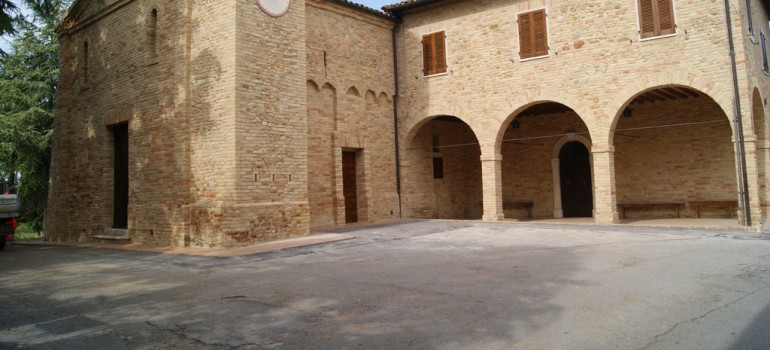
The church of San Giovanni Battista in Pescolla, was erected in 1532 by the will of the people, running at a resolution of the Board of Elders of Ascoli of December 7, 1487, which put an end to a dispute between the inhabitants of the castle and Castorano men Pescolla, for the construction of a new church in the same Villa and neighboring subject. In that resolution was sentenced “quod homines dicte villas possint et valeant build et construere in dicta villa unam ecclesiam de novo.” It was built, probably in place of an already ruined, by masons as Lombard says Peter Capponi in his “Historical Memoirs of the church ascolana and bishops who ruled” in fact already in Catasti of 1381 in the territory of the church is mentioned Castorano St. John the Baptist. It is prepared from east to west with a single nave, with the altar placed to the east and two side altars. At the time of construction it was much lower, internally almost bare, there was only a splendid fresco coeval to its construction and there was a small tower sailing. Only later was equipped with three altarpieces: the painting of St. Anna’s Trasi, that of St. John the Baptist of Cantalamessa and that of the SS Rosario anonymous painter. In 1571 this day of November 29, with the Bull of Peter Camaiani Episcopal Bishop of Ascoli it became parish church, inside there were three graves for burials, one for men, one for women and one for children. There were numerous restorations over the centuries, due to the particular friability of the ground below. The most important was that of 1842, edited and directed by the parish priest Fr Emidio Malaspina, authorized and supported by the Bishop Zelli. Designed by the architect Ignazio Cantalamessa ascolano the church was raised to 14 palms, corresponding to 3.08 meters for the whole perimeter with four pillars to arches for sustaining the roof, three times a camorcanna and renewed in all the altars, the floor , doors and windows. In 1873 the parish priest Fr Emidio Monti had built at his own expense the newsstand wood above the high altar where it is set the canvas of Trasi. Several interventions were made to run by Don Serafino Salvati in 1886, including two key iron reconsolidation of the walls of the church and sacristy. Then again in 1898 built the tower and the porch in the rectory. At the beginning of ‘900 bought a fine pipe organ, made in 1922 to repair a part of the time and then made her entirely frescoed by a young and unknown professor of Rome, De Barberis who became famous under fascism. Don Domenico Guidotti, made to work in 1929 and in 1947. In the late sixties, through the work of Don Severino Volpi was redone the floor of the apse, took off the wooden balustrades and added there was an altar so that the parish priest could celebrate Mass facing the congregation, were removed the wooden platforms under the side altars and in their place were put benches. Still in 1989 Don Severino Volpi did do work inside the church with the help of the artisans of Pescolla and a collection among the parishioners themselves. In the mid-nineties, by which time the church was no longer parish church, was the pastor of Castorano Don Giuseppe Damiani to do work on the roof of the church, because the water seepage had hopelessly compromised the time to camorcanna with paintings of Barberis. And we come to the present day, Don Cesare Cossignani within a few years, did restore the former rectory, the church tower and bringing the entire complex to its former glory as we can admire today.
Altri monumenti a Castorano
 Lascia un commento
Lascia un commento